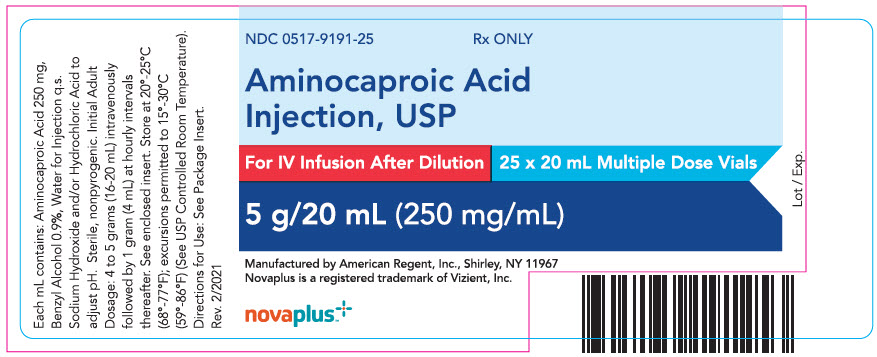Label: AMINOCAPROIC ACID injection, solution
- NDC Code(s): 0517-9191-01, 0517-9191-25
- Packager: American Regent, Inc.
- Category: HUMAN PRESCRIPTION DRUG LABEL
- DEA Schedule: None
- Marketing Status: Abbreviated New Drug Application
Drug Label Information
Updated July 16, 2020
If you are a consumer or patient please visit this version.
- Download DRUG LABEL INFO: PDF XML
- Official Label (Printer Friendly)
- SPL UNCLASSIFIED SECTION
-
DESCRIPTION
Aminocaproic Acid is 6-aminohexanoic acid, which acts as an inhibitor of fibrinolysis. The structural formula is:
NH2CH2(CH2)3CH2COOH
The molecular formula is: C6H13NO2 Molecular Weight: 131.17
Aminocaproic Acid is soluble in water, acid and alkaline solutions; it is sparingly soluble in methanol and practically insoluble in chloroform.
Aminocaproic Acid Injection, USP, for intravenous administration, is a sterile pyrogen-free solution containing 250 mg/mL of Aminocaproic Acid with Benzyl Alcohol 0.9%, as a preservative, and Water for Injection q.s. The pH is adjusted to approximately 6.8 with Hydrochloric Acid and/or Sodium Hydroxide.
-
CLINICAL PHARMACOLOGY
The fibrinolysis-inhibitory effects of aminocaproic acid appear to be exerted principally via inhibition of plasminogen activators and to a lesser degree through antiplasmin activity.
In adults, oral absorption appears to be a zero-order process with an absorption rate of 5.2 g/hr. The mean lag time in absorption is 10 minutes. After a single oral dose of 5 g, absorption was complete (F=1). Mean ± SD peak plasma concentrations (164 ± 28 mcg/mL) were reached within 1.2 ± 0.45 hours.
After oral administration, the apparent volume of distribution was estimated to be 23.1 ± 6.6 L (mean ± SD). Correspondingly, the volume of distribution after intravenous administration has been reported to be 30.0 ± 8.2 L. After prolonged administration, aminocaproic acid has been found to distribute throughout extravascular and intravascular compartments of the body, penetrating human red blood cells as well as other tissue cells.
Renal excretion is the primary route of elimination, whether aminocaproic acid is administered orally or intravenously. Sixty-five percent of the dose is recovered in the urine as unchanged drug and 11% of the dose appears as the metabolite adipic acid. Renal clearance (116 mL/min) approximates endogenous creatinine clearance. The total body clearance is 169 mL/min. The terminal elimination half-life for aminocaproic acid is approximately 2 hours.
-
INDICATIONS AND USAGE
Aminocaproic Acid Injection is useful in enhancing hemostasis when fibrinolysis contributes to bleeding. In life-threatening situations, fresh whole blood transfusions, fibrinogen infusions, and other emergency measures may be required.
Fibrinolytic bleeding may frequently be associated with surgical complications following heart surgery (with or without cardiac bypass procedures), and portacaval shunt; hematological disorders such as aplastic anemia; acute and life-threatening abruptio placentae; hepatic cirrhosis; and neoplastic disease such as carcinoma of the prostate, lung, stomach, and cervix.
Urinary fibrinolysis, usually a normal physiological phenomenon, may frequently be associated with life-threatening complications following severe trauma, anoxia, and shock. Symptomatic of such complications is surgical hematuria (following prostatectomy and nephrectomy) or nonsurgical hematuria (accompanying polycystic or neoplastic diseases of the genitourinary system). (See WARNINGS.)
-
CONTRAINDICATIONS
Aminocaproic acid should not be used when there is evidence of an active intravascular clotting process.
When there is uncertainty as to whether the cause of bleeding is primary fibrinolysis or disseminated intravascular coagulation (DIC), this distinction must be made before administering aminocaproic acid.
The following tests can be applied to differentiate the two conditions:
- Platelet count is usually decreased in DIC but normal in primary fibrinolysis.
- Protamine paracoagulation test is positive in DIC; a precipitate forms when protamine sulfate is dropped into citrated plasma. The test is negative in the presence of primary fibrinolysis.
- The euglobulin clot lysis test is abnormal in primary fibrinolysis but normal in DIC.
Aminocaproic acid must not be used in the presence of DIC without concomitant heparin.
-
WARNINGS
Aminocaproic Acid Injection, USP contains benzyl alcohol as a preservative. The administration of medications containing benzyl alcohol as a preservative to premature neonates has been associated with a fatal “Gasping Syndrome”. (See PRECAUTIONS, Pediatric Use.)
In patients with upper urinary tract bleeding, aminocaproic acid administration has been known to cause intrarenal obstruction in the form of glomerular capillary thrombosis or clots in the renal pelvis and ureters. For this reason, aminocaproic acid should not be used in hematuria of upper urinary tract origin, unless the possible benefits outweigh the risk.
Subendocardial hemorrhages have been observed in dogs given intravenous infusions of 0.2 times the maximum human therapeutic dose of aminocaproic acid and in monkeys given 8 times the maximum human therapeutic dose of aminocaproic acid.
Fatty degeneration of the myocardium has been reported in dogs given intravenous doses of aminocaproic acid at 0.8 to 3.3 times the maximum human therapeutic dose and in monkeys given intravenous doses of aminocaproic acid at 6 times the maximum human therapeutic dose.
Rarely, skeletal muscle weakness with necrosis of muscle fibers has been reported following prolonged administration. Clinical presentation may range from mild myalgias with weakness and fatigue to a severe proximal myopathy with rhabdomyolysis, myoglobinuria, and acute renal failure. Muscle enzymes, especially creatine phosphokinase (CPK) are elevated. CPK levels should be monitored in patients on long-term therapy. Aminocaproic acid administration should be stopped if a rise in CPK is noted. Resolution follows discontinuation of aminocaproic acid; however, the syndrome may recur if aminocaproic acid is restarted.
The possibility of cardiac muscle damage should also be considered when skeletal myopathy occurs. One case of cardiac and hepatic lesions observed in man has been reported. The patient received 2 g of aminocaproic acid every 6 hours for a total dose of 26 g. Death was due to continued cerebrovascular hemorrhage. Necrotic changes in the heart and liver were noted at autopsy.
-
PRECAUTIONS
General
Aminocaproic acid inhibits both the action of plasminogen activators and to a lesser degree, plasmin activity. The drug should NOT be administered without a definite diagnosis and/or laboratory finding indicative of hyperfibrinolysis (hyperplasminemia).*
Rapid intravenous administration of the drug should be avoided since this may induce hypotension, bradycardia, and/or arrhythmia.
Inhibition of fibrinolysis by aminocaproic acid may theoretically result in clotting or thrombosis. However, there is no definite evidence that administration of aminocaproic acid has been responsible for the few reported cases of intravascular clotting which followed this treatment. Rather, it appears that such intravascular clotting was most likely due to the patient’s preexisting clinical condition, e.g., the presence of DIC. It has been postulated that extravascular clots formed in vivo may not undergo spontaneous lysis as do normal clots.
Reports have appeared in the literature of an increased incidence of certain neurological deficits such as hydrocephalus, cerebral ischemia, or cerebral vasospasm associated with the use of antifibrinolytic agents in the treatment of subarachnoid hemorrhage (SAH). All of these events have also been described as part of the natural course of SAH, or as a consequence of diagnostic procedures such as angiography. Drug relatedness remains unclear.
Thrombophlebitis, a possibility with all intravenous therapy, should be guarded against by strict attention to the proper insertion of the needle and the fixing of its position.
Epsilon-aminocaproic acid should not be administered with Factor IX Complex concentrates or Anti-Inhibitor Coagulant concentrates, as the risk of thrombosis may be increased.
Laboratory Tests
The use of aminocaproic acid should be accompanied by tests designed to determine the amount of fibrinolysis present. There are presently available: (a) general tests such as those for the determination of the lysis of a clot of blood or plasma; and (b) more specific tests for the study of various phases of fibrinolytic mechanisms. These latter tests include both semiquantitative and quantitative techniques for the determination of profibrinolysin, fibrinolysin, and antifibrinolysin.
DRUG & OR LABORATORY TEST INTERACTIONS
Prolongation of the template bleeding time has been reported during continuous intravenous infusion of aminocaproic acid at dosages exceeding 24 g/day. Platelet function studies in these patients have not demonstrated any significant platelet dysfunction. However, in vitro studies have shown that at high concentrations (7.4 mMol/L or 0.97 mg/mL and greater) EACA inhibits ADP and collagen-induced platelet aggregation, the release of ATP and serotonin, and the binding of fibrinogen to the platelets in a concentration-response manner. Following a 10 g bolus of aminocaproic acid, transient peak plasma concentrations of 4.6 mMol/L or 0.60 mg/mL have been obtained. The concentration of aminocaproic acid necessary to maintain inhibition of fibrinolysis is 0.99 mMol/L or 0.13 mg/mL. Administration of a 5 g bolus followed by 1 to 1.25 g/hr should achieve and sustain plasma levels of 0.13 mg/mL. Thus, concentrations which have been obtained in vivo clinically in patients with normal renal function are considerably lower than the in vitro concentrations found to induce abnormalities in platelet function tests. However, higher plasma concentrations of aminocaproic acid may occur in patients with severe renal failure.
Carcinogenesis, Mutagenesis, Impairment of Fertility
Long-term studies in animals to evaluate the carcinogenic potential of aminocaproic acid and studies to evaluate its mutagenic potential have not been conducted. Dietary administration of an equivalent of the maximum human therapeutic dose of aminocaproic acid to rats of both sexes impaired fertility as evidenced by decreased implantations, litter sizes and number of pups born.
Pregnancy
Pregnancy Category C. Animal reproduction studies have not been conducted with aminocaproic acid. It is also not known whether aminocaproic acid can cause fetal harm when administered to a pregnant woman or can affect reproduction capacity. Aminocaproic acid should be given to a pregnant woman only if clearly needed.
Nursing Mothers
It is not known whether this drug is excreted in human milk. Because many drugs are excreted in human milk, caution should be exercised when aminocaproic acid is administered to a nursing woman.
Pediatric Use
Safety and effectiveness in pediatric patients have not been established.
Aminocaproic Acid Injection, USP contains benzyl alcohol as a preservative. Benzyl alcohol has been associated with a fatal “gasping syndrome” in neonates. The “gasping syndrome”, characterized by central nervous system depression, metabolic acidosis, gasping respirations, and high levels of benzyl alcohol and its metabolites found in the blood and urine, has been associated with exposure to benzyl alcohol in neonates and low-birth weight neonates. Additional symptoms may include gradual neurological deterioration, seizures, intracranial hemorrhage, hematologic abnormalities, skin breakdown, hepatic and renal failure, hypotension, bradycardia, and cardiovascular collapse (see WARNINGS).
-
ADVERSE REACTIONS
Aminocaproic acid is generally well tolerated. The following adverse experiences have been reported:
General: Edema, headache, malaise.
Hypersensitivity Reactions: Allergic and anaphylactoid reactions, anaphylaxis.
Local Reactions: Injection site reactions, pain and necrosis.
Cardiovascular: Bradycardia, hypotension, peripheral ischemia, thrombosis.
Gastrointestinal: Abdominal pain, diarrhea, nausea, vomiting.
Hematologic: Agranulocytosis, coagulation disorder, leukopenia, thrombocytopenia.
Musculoskeletal: CPK increased, muscle weakness, myalgia, myopathy (see WARNINGS), myositis, rhabdomyolysis.
Neurologic: Confusion, convulsions, delirium, dizziness, hallucinations, intracranial hypertension, stroke, syncope.
Respiratory: Dyspnea, nasal congestion, pulmonary embolism.
Skin: Pruritus, rash.
Special Senses: Tinnitus, vision decreased, watery eyes.
Urogenital: BUN increased, renal failure. There have been some reports of dry ejaculation during the period of aminocaproic acid treatment. These have been reported to date only in hemophilia patients who received the drug after undergoing dental surgical procedures. However, this symptom resolved in all patients within 24 to 48 hours of completion of therapy.
-
OVERDOSAGE
A few cases of acute overdosage with aminocaproic acid administered intravenously have been reported. The effects have ranged from no reaction to transient hypotension to severe acute renal failure leading to death. One patient with a history of brain tumor and seizures experienced seizures after receiving an 8 gram bolus injection of aminocaproic acid. The single dose of aminocaproic acid causing symptoms of overdosage or considered to be life-threatening is unknown. Patients have tolerated doses as high as 100 grams while acute renal failure has been reported following a dose of 12 grams.
The intravenous and oral LD50 of aminocaproic acid were 3 and 12 g/kg, respectively, in the mouse and 3.2 and 16.4 g/kg, respectively, in the rat. An intravenous infusion dose of 2.3 g/kg was lethal in the dog. On intravenous administration, tonic-clonic convulsions were observed in dogs and mice.
No treatment for overdosage is known, although evidence exists that aminocaproic acid is removed by hemodialysis and may be removed by peritoneal dialysis. Pharmacokinetic studies have shown that total body clearance of aminocaproic acid is markedly decreased in patients with severe renal failure.
-
DOSAGE AND ADMINISTRATION
Aminocaproic Acid Injection, USP is administered by infusion, utilizing the usual compatible intravenous vehicles (e.g., Sterile Water for Injection, Sodium Chloride Injection 0.9%, Dextrose Injection 5% or Ringer’s Injection). Although Sterile Water for Injection is compatible for intravenous injection, the resultant solution is hypo-osmolar. RAPID INJECTION OF AMINOCAPROIC ACID INJECTION, USP UNDILUTED INTO A VEIN IS NOT RECOMMENDED.
For the treatment of acute bleeding syndromes due to elevated fibrinolytic activity, it is suggested that 16 to 20 mL (4 to 5 g) of Aminocaproic Acid Injection, USP in 250 mL of diluent be administered by infusion during the first hour of treatment, followed by a continuing infusion at the rate of 4 mL (1 g) per hour in 50 mL of diluent. This method of treatment would ordinarily be continued for about 8 hours or until the bleeding situation has been controlled.
Parenteral drug products should be inspected visually for particulate matter and discoloration prior to administration, whenever solution and container permit.
Oral Therapy:
If the patient is able to take medication by mouth, an identical dosage regimen may be followed by administering aminocaproic acid tablets or aminocaproic acid syrup, 25% as follows: For the treatment of acute bleeding syndromes due to elevated fibrinolytic activity, it is suggested that 5 grams of aminocaproic acid tablets or syrup be administered during the first hour of treatment, followed by a continuing rate of 1 gram of aminocaproic acid tablets or 1.25 grams of aminocaproic acid syrup per hour. This method of treatment would ordinarily be continued for about 8 hours or until the bleeding situation has been controlled.
-
HOW SUPPLIED
Aminocaproic Acid Injection, USP, 250 mg/mL.
For intravenous infusion after dilution.
NDC 0517-9191-25 20 mL multiple dose vial Boxes of 25
Store at 20°-25°C (68°-77°F); excursions permitted to 15°-30°C (59°-86°F) (See USP Controlled Room Temperature).
Manufactured by:
American Regent, Inc.
Shirley, NY 11967Novaplus is a registered trademark of Vizient, Inc.
IN9191
Rev. 05/2020
MG #44618
- REFERENCES
-
PACKAGE LABEL.PRINCIPAL DISPLAY PANEL
PRINCIPAL DISPLAY PANEL - 20 mL Container
NDC 0517-9191-01 Rx ONLY
Aminocaproic Acid Injection, USP
For IV Infusion After Dilution
20 mL Multiple Dose Vial
5 g/20 mL (250 mg/20 mL)
Manufactured by: American Regent, Inc., Shirley, NY 11967
Novaplus is a registered trademark of Vizient, Inc.


PRINCIPAL DISPLAY PANEL – 20 mL CartonNDC 0517-9191-25 Rx ONLY
Aminocaproic Acid Injection, USP
For IV Infusion After Dilution
25 x 20 mL Multiple Dose Vial
5 g/20 mL (250 mg/mL)
Manufactured by: American Regent, Inc., Shirley, NY 11967
Novaplus is a registered trademark of Vizient, Inc.

- Serialization Label
-
INGREDIENTS AND APPEARANCE
AMINOCAPROIC ACID
aminocaproic acid injection, solutionProduct Information Product Type HUMAN PRESCRIPTION DRUG Item Code (Source) NDC:0517-9191 Route of Administration INTRAVENOUS Active Ingredient/Active Moiety Ingredient Name Basis of Strength Strength AMINOCAPROIC ACID (UNII: U6F3787206) (AMINOCAPROIC ACID - UNII:U6F3787206) AMINOCAPROIC ACID 250 mg in 1 mL Inactive Ingredients Ingredient Name Strength BENZYL ALCOHOL (UNII: LKG8494WBH) SODIUM HYDROXIDE (UNII: 55X04QC32I) HYDROCHLORIC ACID (UNII: QTT17582CB) WATER (UNII: 059QF0KO0R) Packaging # Item Code Package Description Marketing Start Date Marketing End Date 1 NDC:0517-9191-25 25 in 1 TRAY 02/01/2019 1 NDC:0517-9191-01 20 mL in 1 VIAL, MULTI-DOSE; Type 0: Not a Combination Product Marketing Information Marketing Category Application Number or Monograph Citation Marketing Start Date Marketing End Date ANDA ANDA071192 02/01/2019 Labeler - American Regent, Inc. (002033710) Registrant - American Regent, Inc. (002033710) Establishment Name Address ID/FEI Business Operations American Regent, Inc. 002033710 analysis(0517-9191) , manufacture(0517-9191)







